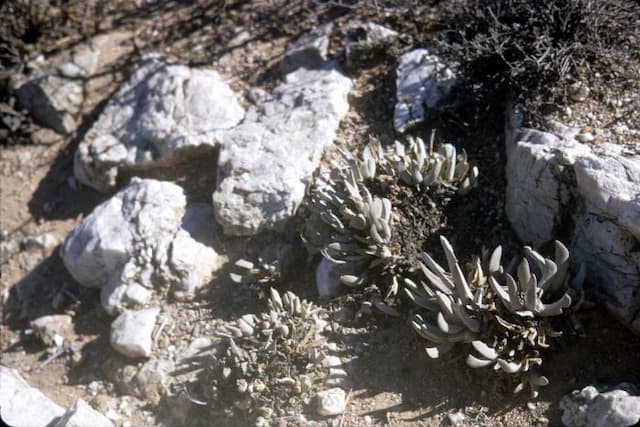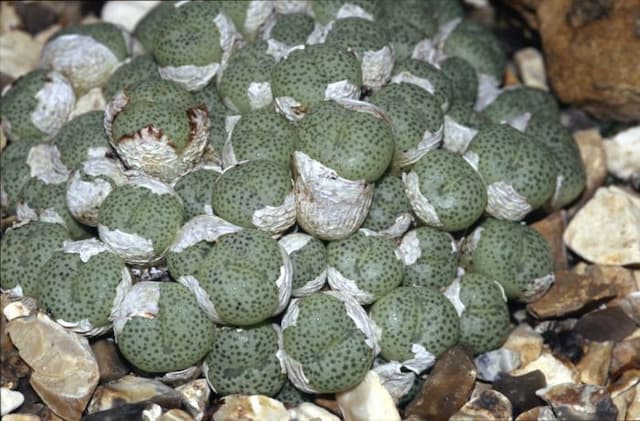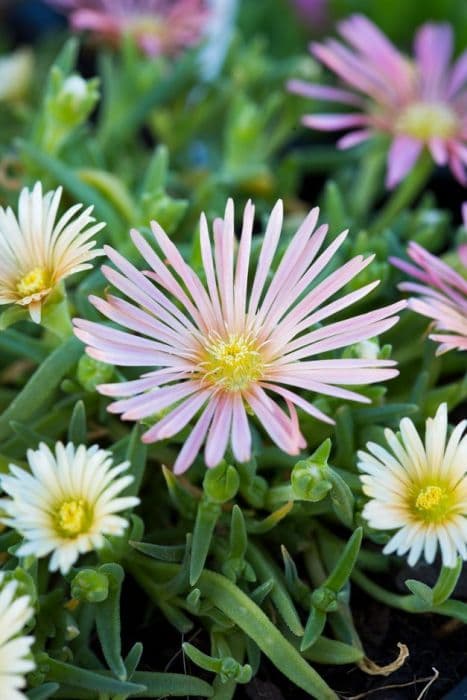Carpet Weed Cheiridopsis denticulata

ABOUT
Cheiridopsis denticulata, commonly referred to as "Denticulate Leaf Cheiridopsis," is a succulent plant originating from South Africa. This plant has a unique and attractive appearance, characterized by pairs of thick, fleshy leaves that are a deep green in color. The leaves are typically shaped with a triangular cross-section, with a keel along the lower surface. The margins of the leaves are finely toothed, giving it the name "denticulata," which suggests a serrated or tooth-like pattern. These teeth-like notches along the leaf edges add to the distinctive texture of the plant. During its flowering season, the plant produces bright yellow flowers that emerge from the center of the leaf pair. The blossoms are daisy-like in shape, often with numerous petals radiating around a central core, and they bring a vivid splash of color against the backdrop of the green foliage. Over time, Cheiridopsis denticulata forms clusters as it produces offsets. It has a compact and clustered appearance, which is often spread across the surface on which it's grown. The overall impression of this plant is one of resilience and charm, with its plump leaves and cheerful flowers, adapted to thrive in harsh, arid environments.
About this plant
 Names
NamesSynonyms
Pebble Plant, Stone Plant, Ring-of-Pearls
Common names
Cheiridopsis denticulata.
 Toxicity
ToxicityTo humans
Cheiridopsis denticulata, commonly known as pebble plants, is not widely recognized as toxic to humans. There are no well-documented cases or extensive reports which suggest the presence of toxic compounds that could cause harm if ingested. Remember to utilize caution when handling unknown plants and consult a medical professional if ingestion occurs and any adverse symptoms are experienced.
To pets
Pebble plants, the common name for Cheiridopsis denticulata, are not well known to be toxic to pets. There is a lack of concrete evidence indicating that this succulent plant poses a threat if ingested by animals such as cats and dogs. However, always exercise caution and keep plants out of reach of pets. In the event that a pet ingests any part of the plant and shows signs of illness, it is best to seek veterinary care promptly.
 Characteristics
CharacteristicsLife cycle
Perennials
Foliage type
Evergreen
Color of leaves
Varies
Flower color
Yellow
Height
0.5 feet (15 cm)
Spread
0.5 feet (15 cm)
Plant type
Succulent
Hardiness zones
10
Native area
South Africa
Benefits
 General Benefits
General Benefits- Drought Tolerance: Cheiridopsis denticulata, commonly known as "Karoo split rock," is highly adapted to survive in arid conditions, making it an ideal plant for drought-prone regions or water-wise gardens.
- Low Maintenance: This plant requires minimal care once established, as it is accustomed to a harsh environment, making it perfect for gardeners who prefer low-maintenance plants.
- Aesthetic Appeal: With its unique shape and interesting foliage, Karoo split rock can add an exotic and artistic touch to rockeries, succulent gardens, or as a container plant.
- Attracts Pollinators: During its flowering season, the bright, daisy-like flowers of Cheiridopsis denticulata attract a variety of pollinators, which can help support the local ecosystem.
- Succulent Collection Diversity: For collectors of succulents, adding Cheiridopsis denticulata can increase the botanical diversity of their collection due to its distinctive features and growth habits.
- Propagation Ease: Karoo split rock can be easily propagated from cuttings or leaves, making it simple for enthusiasts to share and spread the plant.
- Soil Improvement: This succulent can help improve soil structure by breaking up compact soils with its root system, making it beneficial for improving garden soil health.
 Medical Properties
Medical Properties- This plant is not used for medical purposes.
 Air-purifying Qualities
Air-purifying QualitiesThis plant is not specifically known for air purifying qualities.
 Other Uses
Other Uses- Cheiridopsis denticulata foliage can be used in floral arrangements or as a filler in bouquets due to its unique appearance and texture.
- This plant, known as Karoo Chandelier, can be a subject of botanical sketches or photography, serving as inspiration for artists and photographers with its interesting structure.
- The Karoo Chandelier might be grown as a parent plant in hybridization programs aimed at creating new succulent varieties with desirable traits.
- Being drought-tolerant, Cheiridopsis denticulata can be used in xeriscaping and water-wise gardening practices to conserve water.
- The compact size of Karoo Chandelier makes it suitable for miniature gardens or fairy gardens as a realistic miniature plant model.
- It can serve an educational purpose in schools or botanical gardens in teaching about succulent plant adaptations and survival in arid environments.
- Karoo Chandelier's distinct leaf pairs make it a novel choice for decorating terrariums, adding texture and interest within the glass enclosures.
- This plant can be used in green roofs and vertical gardens due to its low-maintenance nature and shallow root system.
- As a natural art object, an entire Cheiridopsis denticulata plant or its parts can be incorporated into living sculptures or eco-friendly art installations.
- Seed pods of Karoo Chandelier can be collected and used for educational demonstrations on seed dispersal mechanisms among succulent plants.
Interesting Facts
 Feng Shui
Feng ShuiThe Tiger Jaws is not used in Feng Shui practice.
 Zodiac Sign Compitability
Zodiac Sign CompitabilityThe Tiger Jaws is not used in astrology practice.
 Plant Symbolism
Plant Symbolism- Resilience: Cheiridopsis denticulata, commonly known as Denticulate-leaved Cheiridopsis, is a succulent that thrives in harsh, arid conditions, symbolizing the ability to endure and prosper despite challenges.
- Adaptability: This plant's capacity to adapt to its environment represents flexibility and the ability to adjust to changing circumstances.
- Self-sufficiency: Denticulate-leaved Cheiridopsis can store water in its leaves, which symbolizes independence and self-reliance.
- Beauty in Simplicity: The simple yet striking appearance of the plant, with its fleshy leaves and daisy-like flowers, exemplifies finding beauty in simple, unadorned forms.
- Rarity: As a less common succulent, Cheiridopsis denticulata can represent uniqueness and the value of rare traits or qualities.
 Water
WaterFor Tiger's Jaw, allow the soil to completely dry out between waterings, which generally means watering about once every two weeks, but this frequency can be less during the winter dormant period. When watering, thoroughly drench the soil until water runs out of the drainage holes of the pot. Typically, using about 8-12 ounces of water for a 5-inch pot is sufficient, depending on the pot size and the environmental conditions. Adjust the amount to ensure the roots get enough moisture without leaving the soil waterlogged, as this can cause root rot.
 Light
LightTiger's Jaw thrives in bright, indirect sunlight, making a south-facing or east-facing windowsill an ideal spot for the plant. Ensure it gets at least 4-6 hours of sunlight daily, but protect it from the harsh midday sun, which can scorch its leaves. If natural light is insufficient, supplement with grow lights to maintain its vibrant color and compact form.
 Temperature
TemperatureTiger's Jaw prefers temperatures between 50°F and 75°F, which are typical for indoor environments. It can tolerate a temperature as low as 40°F in winter and as high as 80°F in summer, but any extreme beyond these ranges can stress the plant. To ensure healthy growth, maintain a stable temperature within its preferred range, avoiding sudden fluctuations.
 Pruning
PruningTiger's Jaw generally requires minimal pruning. Remove only dead or damaged leaves to maintain the plant's appearance, and do it gently to avoid harming the succulent leaves. The best time to prune is during the spring when the plant is entering its active growth phase. Pruning can be done annually or as needed to remove any unsightly or unhealthy foliage.
 Cleaning
CleaningAs needed
 Soil
SoilThe best soil mix for Tiger Jaw (Cheiridopsis denticulata) is a well-draining succulent or cactus mix, with added perlite or sand for extra drainage. This plant prefers a slightly acidic to neutral pH between 6.0 and 7.5.
 Repotting
RepottingTiger Jaw should be repotted every 2-3 years or when it outgrows its current pot, usually after the dormant season in late winter or early spring.
 Humidity & Misting
Humidity & MistingTiger Jaw thrives in low to moderate humidity levels typical of household environments; avoid high humidity to prevent rot.
 Suitable locations
Suitable locationsIndoor
Place Tiger Jaw in bright, indirect light and ensure good ventilation.
Outdoor
Plant in full sun to partial shade with well-draining soil.
Hardiness zone
9b-11b USDA.
 Life cycle
Life cycleCheiridopsis denticulata, commonly known as Pebble Plant or Ice Plant, begins its life cycle as a seed, which germinates when conditions are favorable, usually after rainfall. The seedling stage follows germination, characterized by small, succulent leaves that start to develop the distinctive pebble-like appearance of the adult plants. As it enters the juvenile stage, the plant establishes a stronger root system and develops more leaves, preparing for the dry periods it naturally endures in its native habitat. The plant reaches maturity within several years, at which point it can produce yellow or orange flowers that bloom mainly in winter to spring depending on the climate. After pollination, typically by insects, the flowers develop into fruits that contain seeds, completing the reproductive cycle. Throughout its life, the Pebble Plant undergoes periods of dormancy, particularly during hot and dry summers, where it minimizes growth to conserve resources.
 Propogation
PropogationPropogation time
Spring-Early Summer
The most popular method of propagation for Cheiridopsis denticulata, commonly known as Denticulate Leaf Cheiridopsis, is through seed. Sowing seeds can be done in the spring when temperatures start to increase. To propagate, surface sow the seeds onto a well-draining soil mix, as they require light for germination. Covering the seeds with a thin layer of sand or fine grit can help maintain moisture and still allow light to reach the seeds. Keep the soil moist but not waterlogged, and place the container in a warm place with plenty of indirect sunlight. Germination can be expected in a few weeks, after which seedlings should be carefully watered until they are large enough to be transplanted.









